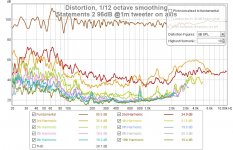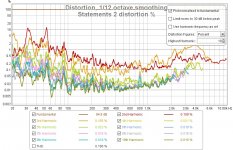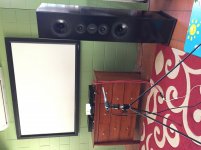A little reference to correct terminology:
near field - only applies to a source in a free field, not a room, gets longer as freq goes up
Far field - only applies to a source in a free field not a room, happens once the field falls at 6 dB/DD
Direct field - only applies to a sound field in a closed space, happens when the field is falling at 6 dB/DD which also implies reflections << direct sound
Reverberant field - only applies to a sound field in a closed space, this field is constant with distance from the source, almost all reflected sound.
And yes, "Near field" monitors is improper usage. They should be called "Direct field" monitors.
I also use the term "Direct sound" to mean the sound that arrives first before any reflections.
near field - only applies to a source in a free field, not a room, gets longer as freq goes up
Far field - only applies to a source in a free field not a room, happens once the field falls at 6 dB/DD
Direct field - only applies to a sound field in a closed space, happens when the field is falling at 6 dB/DD which also implies reflections << direct sound
Reverberant field - only applies to a sound field in a closed space, this field is constant with distance from the source, almost all reflected sound.
And yes, "Near field" monitors is improper usage. They should be called "Direct field" monitors.
I also use the term "Direct sound" to mean the sound that arrives first before any reflections.
Last edited:
Sooooooo not to get off topic but who does make the lowest distortion loudspeaker drivers?
I think it's VERY relevant. Because how low do we want it to be?
Today I took a measurement at 1m.
And the natural background noise of my room is around 50dB during the daytime...
Attachments
Last edited:
Sooooooo not to get off topic but who does make the lowest distortion loudspeaker drivers?
Sh!t, that "ship sailed" 78 pages ago.
-makes me wonder what the hell people have been "discussing" for those 78 pages?
Recently it seems to wanking terminology (..as if anyone cares about that).
..I'll "throw a frikken bone" then:
Bass:
Visaton TIW300: it's linear ..well, for its resonance, cabinet volume, etc.. nice low non-linear distortion: even near resonance. Only capable of modest excursion though. The "400" probably improves on all of this.
Bass-midrange:
Scan Speak 26W/8534G00: 50-500 Hz - it's just about faultless provided excursion is kept to about half it's linear range.
Midrange:
BG Neo 10. Easily correctable freq. response (up into the lower treble). Very well controlled linear response (..as in NOT a choppy/oscillating freq. response, or said differently: well-damped.) Excellent non-linear distortion with the right passband and filter.
Treble (upper):
Viawave RT850. Above 4 kHz in can barely be faulted except for its vertical response (..which is typical for a ribbon tweeter). Excellent linear and non-linear response. (..it's not bad below 4 kHz either, but it's not stellar.) Again, dependent on the right passband and filter.
Last edited:
Sooooooo not to get off topic but who does make the lowest distortion loudspeaker drivers?
When someone is showing you the way by pointing it with his finger you should not focus your attention too much on the finger IMO.
I think it's VERY relevant. Because how low do we want it to be?
Today I took a measurement at 1m.
And the natural background noise of my room is around 50dB during the daytime...
This thread should be feeded with measurements... and discussions about them because our high NF should ruin the THD measurements in theory.
Just to point out the short-sightedness of this thread, the answer regarding most kinds of "distortion" is electrostatic speakers. In terms of "close your eyes and imagine Gil Shahan is playing the violin in front of you" they are the winner.Sooooooo not to get off topic but who does make the lowest distortion loudspeaker drivers?
There are other exotic technologies like plasma and graphene out there too. But for sure, the answer would not be the crude cone speakers and wooden boxes that are the focus of this thread.
B.
I don't fully agree with planars being clean. That may hold to moderate spl, but after certain level they "explode". Coil-maget drivers do it softer.
The nice sound of violin and acoustic guitar etc. Come because of the open baffle which is typical for planar constructions.
The nice sound of violin and acoustic guitar etc. Come because of the open baffle which is typical for planar constructions.
These drivers have very low distortion
HiVi DMN-A Soft Dome Fabric Midrange
Also Satori and Vifa's top of the line drivers and Dayton RS.
To tell you the truth I've never heard a planar or ribbon. I don't listen at high volumes but I can't imagine how you can get any dynamics from something that's barely moving.
Zaph doesn' think very highly of ribbons and planar tweeters, expensive and generally outperformed by typical tweeters, but they do perform very well at the top end where the air is.
HiVi DMN-A Soft Dome Fabric Midrange
Also Satori and Vifa's top of the line drivers and Dayton RS.
To tell you the truth I've never heard a planar or ribbon. I don't listen at high volumes but I can't imagine how you can get any dynamics from something that's barely moving.
Zaph doesn' think very highly of ribbons and planar tweeters, expensive and generally outperformed by typical tweeters, but they do perform very well at the top end where the air is.
Last edited:
Nobody has mentioned the ULTRA LOW DISTORTION series of drivers from BMS like 5S117,6S117, 8S215, 8S219,12S320,15S320 to name a few. These all have triple aluminum demodulation rings, so why don't these seem to get much attention in the forums? They are one of the few manufacturers to actually publish distortion measurements.
Last edited:
Nobody has mentioned the ULTRA LOW DISTORTION series of drivers from BMS like 5S117,6S117, 8S215, 8S219,12S320,15S320 to name a few. These all have triple aluminum demodulation rings, so why don't these seem to get much attention in the forums? They are one of the few manufacturers to actually publish distortion measurements.
I don't think they're intentionally ignored. If they're not available through PE or madisound few would know about them.
Wonder why aluminum shorting rings instead of copper or silver?
aluminum's not that bad, lighter weight than copper. Thats why they use copper clad aluminum wire.
Nobody has mentioned the ULTRA LOW DISTORTION series of drivers from BMS like 5S117,6S117, 8S215, 8S219,12S320,15S320 to name a few. These all have triple aluminum demodulation rings, so why don't these seem to get much attention in the forums? They are one of the few manufacturers to actually publish distortion measurements.
There are two 5" drivers worth using.
On a budget the FaitalPro 5FE120 and for those without tight budget constraints there is the BMS 5S117.
......
aluminum's not that bad, lighter weight than copper. Thats why they use copper clad aluminum wire.
I know about wires, but I was wondering about the usage of aluminum for the shorting rings...
Could be. It is coincidental that when I was playing around with a voice coil from a torn down driver, I stuck an aluminum tube down the middle and the inductance at 10KHz was lower than when using a thicker copper tube. It gave me a surprise.
So I was wondering why didn’t more manufacturers use it instead?
So I was wondering why didn’t more manufacturers use it instead?
The effectiveness of a shorting ring depends on its total resistance - lower is better. Silver has the lowest resistivity, so for a given cross section it will work best. Copper is next and then aluminium. But if we can change the cross sectional area then we can make them all the same, just need more metal for aluminium than copper then silver.
- Home
- Loudspeakers
- Multi-Way
- Who makes the lowest distortion speaker drivers



 Magnetic planars are almost as clean, and very good on strings - which is way you'll often hear Magnapan speakers demoed with violin or cello.
Magnetic planars are almost as clean, and very good on strings - which is way you'll often hear Magnapan speakers demoed with violin or cello.